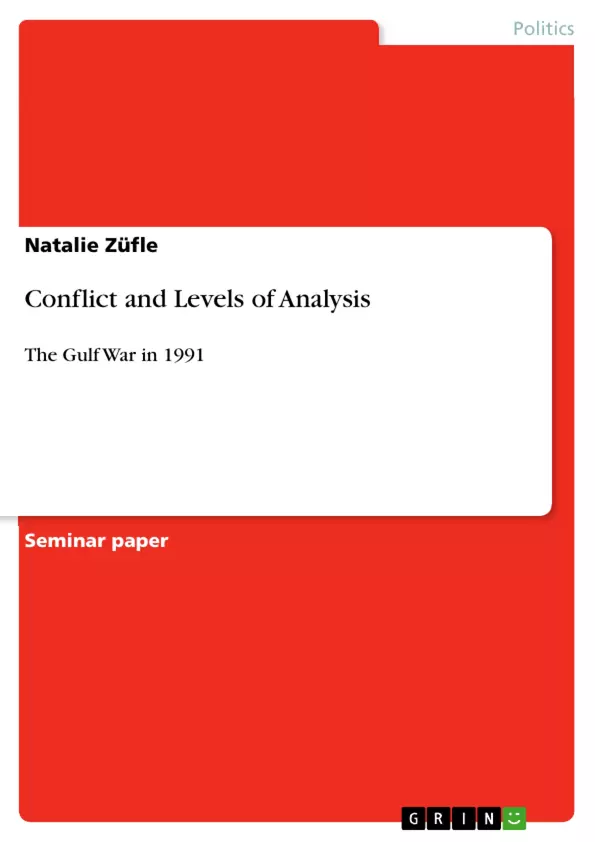The causes of the Gulf War are numerous. On each level of analysis, different reasons can be stated, be it in the personal character of a ruler, the national interest of the state or systemic constraints. From my point of view, there is no single cause that can be made out, but rather every illustrated explanation (and there are many more) accounts for the eruption of the Gulf War. In addition, I want to mention that within this level of analysis approach some important aspects (like values or norms etc.) are neglected, being taken into consideration by other theoretical schools like constructivism.
Inhaltsverzeichnis (Table of Contents)
- The Gulf War in 1991
- The conflict
- Three levels of analysis
- The individual level – Why Iraq seized Kuwait
- The state level - Why the USA stepped in
Zielsetzung und Themenschwerpunkte (Objectives and Key Themes)
This paper analyzes the causes of the 1991 Gulf War through the lens of Kenneth Waltz's three levels of analysis: individual, state, and system. The author seeks to understand why Iraq invaded Kuwait and why the United States led a multinational coalition to intervene.
- Individual level analysis of Saddam Hussein's motivations and decisions
- State level analysis of the United States' foreign policy objectives and the role of democracy in international conflict
- Systemic level analysis of the changing global order and its influence on state behavior
- The role of misperception and cognitive dissonance in international conflict
- The impact of domestic factors on state foreign policy
Zusammenfassung der Kapitel (Chapter Summaries)
The text first outlines the timeline of the 1991 Gulf War, highlighting Iraq's invasion of Kuwait, the subsequent diplomatic efforts and sanctions, and the Allied military intervention. Then, it explores the causes of the conflict through three levels of analysis.
The individual level analysis focuses on Saddam Hussein's motivations, highlighting his ambition for power, his desire to secure valuable oil reserves, and his belief that Kuwait historically belonged to Iraq. The text also discusses Saddam's misperception of the international community's response and the potential influence of US Ambassador Glaspie's ambiguous statements. Finally, it examines the role of Saddam's personal characteristics, such as his aggressiveness, in his decision to invade Kuwait.
The state level analysis centers on the United States' involvement in the conflict. The author argues that the democratic nature of the US and its allies contributed to their decision to intervene, citing the democratic peace theory. The text also discusses the potential impact of domestic factors on the US foreign policy, such as public opinion and economic interests.
Schlüsselwörter (Keywords)
This paper explores key concepts in international relations such as the Gulf War, levels of analysis, individual actor theories, state-level factors, democratic peace theory, misperception, cognitive dissonance, and the influence of international systems.
- Citation du texte
- Natalie Züfle (Auteur), 2009, Conflict and Levels of Analysis , Munich, GRIN Verlag, https://www.grin.com/document/180080



